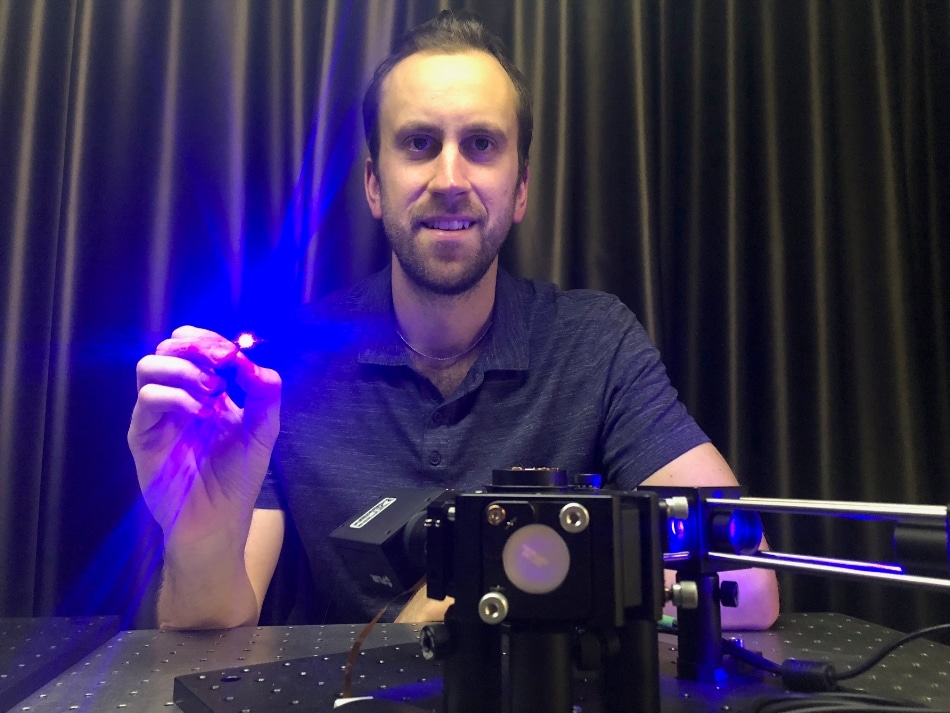Apr 29 2019
Scientists have demonstrated that prevalent optical fiber technology could be employed to create microscopic 3D images of tissue within the body, opening the door toward 3D optical biopsies.
 Dr Antony Orth holding an ultra-thin microendoscope used in the study, which revealed the 3D imaging potential of the existing technology. (Image credit: RMIT University)
Dr Antony Orth holding an ultra-thin microendoscope used in the study, which revealed the 3D imaging potential of the existing technology. (Image credit: RMIT University)
In contrast to usual biopsies in which tissue is collected and transported to a lab for analysis, optical biopsies allow clinicians to analyze living tissue within the body in real time.
This minimally invasive method involves using ultra-thin microendoscopes to examine inside the body for diagnosis or during surgery; however, it typically generates only two-dimensional images.
The study conducted by RMIT University has now uncovered the 3D potential of the prevalent microendoscope technology.
This improvement is reported in Science Advances and is an important first step toward 3D optical biopsies, to enhance diagnosis and precision surgery.
According to lead author Dr Antony Orth, the new method employs a light field imaging strategy to create microscopic images in stereo vision, just like the 3D movies that are viewed using 3D glasses.
Stereo vision is the natural format for human vision, where we look at an object from two different viewpoints and process these in our brains to perceive depth. We’ve shown it’s possible to do something similar with the thousands of tiny optical fibers in a microendoscope. It turns out these optical fibers naturally capture images from multiple perspectives, giving us depth perception at the microscale. Our approach can process all those microscopic images and combine the viewpoints to deliver a depth-rendered visualization of the tissue being examined – an image in three dimensions.
Dr Antony Orth, Research Fellow, RMIT node, ARC Centre of Excellence for Nanoscale BioPhotonics
How it Works
The study showed that optical fiber bundles send 3D information in the form of a light field.
The next challenge for the scientists was to collect the recorded information, decode it, and create an image that seems sensible.
In addition to solving these issues, their new technique operates even when the optical fiber bends and flexes—important for clinical use in the human body.
The method draws on principles of light field imaging, where, conventionally, multiple cameras observe the same scene from somewhat different angles.
Light field imaging systems quantify the angle of the rays striking each camera, recording information about the angular distribution of light to produce a “multi-viewpoint image.”
But how to record this angular information using an optical fiber?
“The key observation we made is that the angular distribution of light is subtly hidden in the details of how these optical fiber bundles transmit light,” Orth said.
“The fibers essentially ‘remember’ how light was initially sent in—the pattern of light at the other side depends on the angle at which light entered the fiber.”
Taking this into account, RMIT scientists and colleagues created a mathematical framework to link the output patterns to the light ray angle.
By measuring the angle of the rays coming into the system, we can figure out the 3D structure of a microscopic fluorescent sample using just the information in a single image. So that optical fiber bundle acts like a miniaturized version of a light field camera. The exciting thing is that our approach is fully compatible with the optical fiber bundles that are already in clinical use, so it’s possible that 3D optical biopsies could be a reality sooner rather than later.
Professor Brant Gibson, Chief Investigator and Deputy Director, CNBP
The ultra-slim light field imaging device could not only be used in medical applications but also be potentially used for in vivo 3D fluorescence microscopy in biological research.
The research, together with CNBP colleagues at Macquarie University and the Centre for Micro-Photonics at Swinburne University, is reported in Science Advances (“Optical fiber bundles: ultra-slim light field imaging probes”).